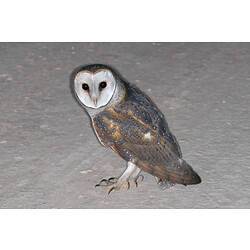General Description
A medium-sized owl with a white 'heart-shaped' facial disc. The body is sandy orange and light grey above, and white to cream underneath. Both the back and breast are evenly spotted with black. Young birds are similar to adults in plumage and females are slightly larger than males. Body size up to 39 cm. Call a 12 second rough, hissing screech.
Biology
It is a moderately common bird, but generally hard to see, as it is nocturnal. During the day, the birds roost in hollow logs, caves or on concealed tree branches, emerging at night to hunt. It feeds mostly on small mammals, rats and mice, and birds, but some insects, frogs and lizards are also eaten. It uses its exceptional hearing to search for prey on the ground. The slightest sound waves are channelled toward the ears, allowing the owl to pinpoint prey even in complete darkness. Barn Owls are the most widespread of the owls, found on every continent in the world except Antarctica. It is generally a quiet bird, with the common call being a 12 second rough, hissing screech. Less frequently, birds give whistling, wheezing notes and some snapping and bill clacking during mating and threat displays.
Distribution
Eastern Australia.
Habitat
Open, often arid (dry) country, such as farms, heath and lightly-wooded forest.
More Information
-
Animal Type
-
Animal SubType
-
Brief Id
Medium sized, white facial disc, orange grey body, white cream underneath.
-
Colours
Grey, White
-
Maximum Size
39 cm
-
Habitats
-
Diet
Carnivore
-
Endemicity
-
Commercial
No
-
Conservation Statuses
CITES: Not listed, FFG Threatened List: Not listed, EPBC Act 1999: Not listed, IUCN Red List: Not listed
-
Taxon Name
-
Common Name
Barn Owl
-
Kingdom
-
Phylum
-
Subphylum
-
Class
-
Order
-
Family
-
Genus
-
Species Name
alba
-
Subspecies
javanica


